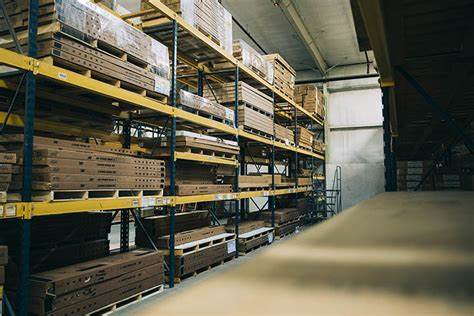Business
Implementing Lean Techniques in Warehousing: A Step-by-Step Guide for Efficient Operations

Optimizing warehouse operations is crucial for business success in today’s highly competitive landscape.
Lean techniques, rooted in the renowned Toyota Production System, offer a systematic approach to streamline processes, eliminate waste, and enhance productivity in warehousing.
This article will give a definition of lean techniques in warehousing, provide a step-by-step guide on implementing lean warehousing and explain the five lean principles in warehousing.
Furthermore, we will explore why incorporating lean warehouse management practices can be immensely beneficial for your organization.
What is Lean Warehouse Management?
Lean warehouse management is a methodology inspired by the famous Toyota Production System, aimed at eliminating waste, improving efficiency, and delivering value to customers.
It involves streamlining processes, enhancing flow, and fostering a culture of continuous improvement within the warehouse environment.
Lean warehouse management helps organizations optimize their operations and remain competitive in a dynamic marketplace by focusing on waste reduction, value creation, and employee engagement.
Three Reasons to Embrace Lean Warehouse Management
1. Elimination of Waste
One of the primary goals of lean warehouse management is to identify and eliminate waste from the operational processes. Waste can come in many different forms, including excess inventory, overproduction, unnecessary transportation, waiting time, and defects.
Implementing lean principles and tools, such as value stream mapping and Kaizen events, allows organizations to identify waste areas and develop strategies to eliminate or minimize them. This waste reduction leads to cost savings, improved efficiency, and better resource utilization, ultimately enhancing the bottom line.
2. Enhanced Operational Efficiency
Lean warehouse management focuses on optimizing processes and creating a smooth flow of materials and information throughout the warehouse.
Organizations can reduce cycle times, minimize disruptions, and increase throughput by analyzing the value stream, identifying bottlenecks, and implementing improvements.
Implementing lean tools, such as visual management boards, standardized work instructions, and cross-training, helps ensure that operations run smoothly with minimal errors and delays. This enhanced efficiency translates into shorter lead times, improved on-time deliveries, and higher customer satisfaction.
3. Cultivation of a Culture of Continuous Improvement
A fundamental aspect of lean warehouse management is fostering a culture of constant improvement within the organization. It involves empowering employees at all levels to identify and implement small, incremental changes that lead to significant improvements over time.
Encouraging frontline staff to participate in problem-solving allows organizations to tap into a wealth of knowledge and experience that can drive innovation and efficiency gains.
This collaborative approach boosts employee engagement and satisfaction and cultivates a learning organization that adapts to changing market conditions and stays ahead of the competition.
Why Use Lean Warehouse Management?
Enhanced Productivity: Lean techniques eliminate waste, streamline processes, and optimize resources, leading to significant improvements in productivity. Reducing non-value-added activities and minimizing downtime means that your warehouse operations become more efficient and capable of meeting customer demands promptly.
Reduced Costs: Implementing lean techniques can help you identify and eliminate various forms of waste, including excess inventory, overprocessing, and unnecessary movement. These waste reductions lead to cost savings through lower inventory carrying costs, improved space utilization, and decreased labor requirements.
Improved Customer Satisfaction: Lean warehousing fosters a customer-centric approach by delivering value efficiently and consistently. Reduced lead times, improved order accuracy, and enhanced responsiveness to customer demands contribute to increased customer satisfaction and loyalty.
How to Implement Lean Techniques in Warehousing
Step 1: Understand the Five Lean Principles in Warehousing
Before embarking on your lean journey, it is essential to familiarize yourself with the core principles that underpin lean warehousing. These principles are:
Value Identification: Identify and understand the specific value that customers expect from your warehouse operations. It helps you align your processes to deliver that value efficiently while eliminating non-value-added activities.
Value Stream Mapping: Map out the entire value stream of your warehousing operations, from receiving to shipping. This visualization allows you to identify waste, bottlenecks, and areas for improvement.
Flow Optimization: Aim to establish a smooth flow of materials and information throughout the warehouse. Minimize disruptions, reduce waiting times, and eliminate unnecessary movements to improve efficiency.
Pull-based Systems: Implement a pull-based system where materials are replenished based on actual demand. It avoids overproduction, reduces inventory levels, and enables a more responsive supply chain.
Continuous Improvement: Embrace a culture of constant improvement, where every employee is encouraged to identify and implement small, incremental changes. It fosters a learning organization and ensures sustained progress over time.
Step 2: Assess Current Warehouse Processes
Evaluate your existing warehouse processes to identify areas for improvement. Conduct a thorough analysis of each cycle, looking for waste, bottlenecks, and inefficiencies.
Engage your warehouse staff in this evaluation process, as they possess valuable insights and frontline experience. This assessment will serve as a baseline for measuring future improvements.
Step 3: Identify and Eliminate Waste
Utilize lean tools such as value stream mapping, 5S, and Kaizen events to identify and eliminate waste. Waste can manifest in various forms, including excess inventory, unnecessary movement, overprocessing, waiting time, and defects. Focus on reducing these wastes by implementing appropriate countermeasures and standardizing optimized processes.
Step 4: Streamline Warehouse Layout and Organization
Optimize your warehouse’s physical layout and organization to minimize travel distances, enhance accessibility, and improve overall flow.
Implement the 5S methodology, which involves sorting, setting order, shining, standardizing, and sustaining.
This systematic approach promotes cleanliness and visual management and ensures that necessary tools and materials are readily available.
Step 5: Implement Lean Tools and Techniques
Embrace lean tools and techniques that align with your warehouse operations. These may include Kanban systems for inventory management, error-proofing mechanisms, standardized work instructions, visual management boards, and cross-training of employees to enable flexibility.
Consider investing in technology solutions such as warehouse management systems (WMS) and automated material handling systems to further enhance efficiency.
Five Key Points to Consider Before Implementing Lean Warehouse Management
Lean warehouse management is a powerful strategy that can transform operations and drive efficiency within your warehouse environment. However, before embarking on this journey, you must consider certain critical elements to ensure a successful implementation.
Next, we will look at five essential factors you should carefully consider before implementing lean warehouse management techniques. Maximize the benefits and set the stage for a smooth and effective transition by addressing these points.
1. Organizational Readiness
Before implementing lean warehouse management, assessing your organization’s readiness for change is essential. Evaluate the culture, mindset, and willingness to embrace continuous improvement.
Educate and involve employees at all levels to gain their support and commitment to the new approach. Establish effective communication channels and ensure everyone is aware of the advantages and goals of lean warehouse management.
You can overcome resistance and facilitate a successful transition by fostering a positive and receptive environment.
2. Thorough Planning and Resource Allocation
Implementing lean warehouse management requires careful planning and resource allocation. Devote sufficient time and effort to understand your current processes, identify improvement opportunities, and design an implementation roadmap.
Allocate the necessary human and financial resources to support the transition. It includes providing personnel with proper training to ensure they have the knowledge and abilities to embrace and sustain lean principles. A well-thought-out plan and resource allocation will lay the groundwork for successful implementation and long-term success.
3. Process Standardization and Documentation
Lean warehouse management relies on standardized processes and documentation to drive efficiency and continuous improvement.
Take the time to document and communicate standardized work instructions, standard operating procedures, and visual management tools. It ensures consistency and clarity in operations, reduces errors, and enables employees to understand and follow optimized processes.
Establishing a standardized process foundation creates a platform for continuous improvement and drives sustainable results.
4. Commitment to Continuous Improvement
Lean warehouse management is not a one-time project but a journey of continuous improvement. All organizational levels must make a sustained commitment to it.
Embrace a culture encouraging employees to continuously identify and implement minor improvements. Establish feedback loops, hold regular improvement meetings, and celebrate successes to foster a sense of ownership and motivation.
By cultivating a commitment to continuous improvement, you can sustain the gains achieved through lean practices and drive ongoing excellence.
5. Measuring and Monitoring Performance
It is crucial to establish performance metrics and regularly monitor progress to ensure the success of lean warehouse management. Define key performance indicators (KPIs) that align with your organizational goals, such as cycle time, on-time delivery, and inventory accuracy.
Implement visual management boards or digital dashboards to track and communicate these metrics to all employees. Make data-driven judgments by regularly reviewing and analyzing the data to find areas that need improvement.
Measuring and monitoring performance allows you to stay on track, identify emerging issues, and make timely adjustments to optimize your lean warehouse management strategy.
Conclusion
Implementing lean techniques in your warehouse can significantly enhance efficiency, reduce waste, and optimize resources.
Embrace the five lean principles in warehousing and follow this guide to transform your warehouse operations into a lean, dynamic, and customer-focused environment.
The advantages of lean warehouse management, such as better productivity, lower costs, and more customer satisfaction, make it a desirable investment for any business looking to thrive in today’s competitive market.
-
Blog1 year ago
MyCSULB: Login to CSULB Student and Employee Portal – MyCSULB 2023
-
Android App3 years ago
Cqatest App What is It
-
Android1 year ago
What Is content://com.android.browser.home/ All About in 2023? Set Up content com android browser home
-
Software2 years ago
A Guide For Better Cybersecurity & Data Protection For Your Devices
-
Latest News2 years ago
Soap2day Similar Sites And Alternatives To Watch Free Movies
-
Android2 years ago
What is OMACP And How To Remove It? Easy Guide OMACP 2022
-
Android3 years ago
What is org.codeaurora.snapcam?
-
Business2 years ago
Know Your Business (KYB) Process – Critical Component For Partnerships





















